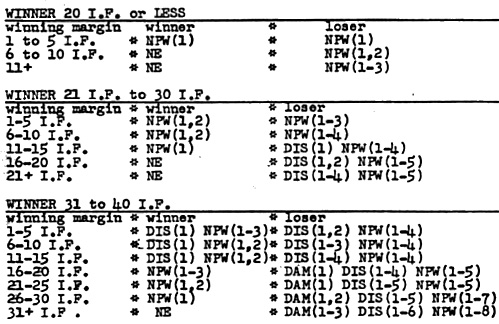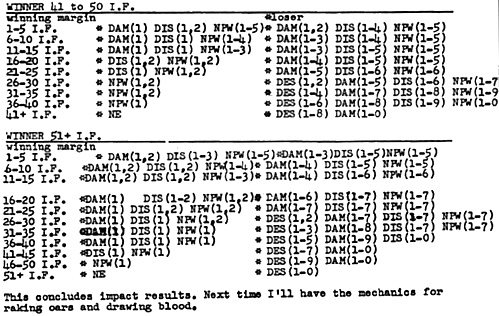Previous to this issue I outlined vessel types, crew sizes, movement, facing and sequence of play for my West European Dark Ages navel rules. At this point I will address the issue of what occurs at the moment that two or more vessels impact each other with deadly intent. In the vast majority of cases this moment will be-rather undramatic. Viking/Saxon/Norman type sea battles often took on the appearance of infantry land battles on floating platforms. However, with skillful maneuver and timing, not unheard of in this era although somewhat rare, a vessel may gain an advantage in melee during the initial stages by disturbing the stability of the enemy vessel.
Only in extreme cases such as the ramming of a very small vessel by a very large one will a vessel be placed in jeopardy of immediate destruction by ramming. Often a vessel attempting a vigorous ramming of another vessel may place his own vessel in danger of damage. It is always desirable to inflict or receive an impact forward of ones Oar Bank line to minimize the disruptive or destructive affect on one's own vessel. It will be easiest to combine movement and the impact result check for each pair of impacting vessels as you proceed through the sequence of play.
The results of impact will be determined by totalling Impact Factors for each pair of vessels and comparing the results on my impact result chart. The critical factors will be speed, Hull Factor, crew level, a small random factor and a minimal number of tactical modifiers. It should be easy to quickly determine results after trying it once-or -twice.
Total Impact Factors (I.P.) for both vessels involved. If a vessel is rammed by two or more vessels in the same turn thou it should adjudicate each impact separately. Thus a vessel involved in multiple impacts in the same turn in at risk for each impact.
Impact Factors
Speed
- Full: 10 I.F.
Paced: 6 I.F.
Slow: 3 I.F.
D.I.W.: 0 I.F.
Hull
- 4: 20 I.F.
3: 15 I.F.
2: 10 I.F.
1: 5 I.F.
Crew Level
- Battle: 15 I.F.
Normal: 10 I.F.
Minial: 5 I.F.
Below Minimum: 0 I.F.
VESSEL IMPACTS ENEMY BEHIND OAR RANK LINE (AFT IMPACT ) --- plus 5 CREW
CONSISTS OF 50% OR MORE VIKnGS --------------------- plus 5
EACH PLAYER ROLLS A SINGIE 1-10 DICE AND ADDS THAT TO HIS TOTAL SCORE.
EXAMPLE: A Snakja longship with a Viking crew impacts another vessel at full speed with a battle crew. Its random roll in 6.
- Speed Full: 10 I.F.
Hull Factor 2: 10 I.F.
Crew Battle: 15 I.F.
Viking crew: 5 I.F.
Random: 6 I.F.
TOTAL: 46 I.F.
This total is now compared to the vessel the Snekja longship is impacting. Let's assume the other vessels total is 40. For Impact Result refer to the Impact Result chart that pertains to Winning vessel 41 to 50 I.F. and look across the raw that pertains to a winning margin of 6 I.F.
IMPACT RESULT CHARTS
RESULT KEY
NPW: No proximity weapon use allowed this turn.
DM: No proximity weapons or break-offs allowed this turn. Vessel
disturbed.
DAM: Vessel damaged. Reduce number of figures on vessel to next
lowest crew level. (players choice) Any full speed moves remaining
are lost. No proximity weapon use or break offs allowed this turn.
Mark the letters DAM an order sheet. Two such results equals a
DES result.
DES: Vessel destroyed. All hands lost/vessel eliminated.
NE: No effect
Refer to appropriate chart for winning vessels total I.F. and the appropriate row for the winners winning margin. The winners result is an the left and the losers result in on the right. More than one possible result may be listed. Each result is followed by parenthesis that indicate the number neoelsary for the result to apply upon rolling one 1-10 die..(i.e. if 1-5 then result applies if one through five inclusive is rolled). Start with the result on the left an there may be more than one possible result, however the result an the left in the most damaging.
If the die roll indicates that that result in to be applied you need not go an. If the vessel passes that result it must go on to test the next result to the right until a result in applied or the vessel has passed an possible results with no penalty. Both winning and losing vessel may be at risk depending an result.


Back to Saga v2n4 Table of Contents
Back to Saga List of Issues
Back to MagWeb Master Magazine List
© Copyright 1986 by Terry Gore
This article appears in MagWeb.com (Magazine Web) on the Internet World Wide Web. Other articles from military history and related magazines are available at http://www.magweb.com